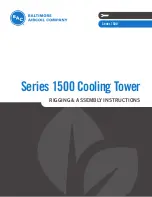
24
Trouble Shooting ReliaTel Controls
The RTRM has the ability to provide the service personnel
with some unit diagnostics and system status information.
Before turning the main power disconnect switch “Off”, follow
the steps below to check the ReliaTel Refrigeration Module
(RTRM). All diagnostics & system status information stored in
the RTRM will be lost when the main power is turned
“Off”
.
HAZARDOUS VOLTAGE!
HIGH VOLTAGE IS PRESENT AT THE TERMINAL BLOCK
OR UNIT MOUNTED DISCONNECT SWITCH.
To prevent injury or death from electrocution, it is the responsi-
bility of the technician to recognize this hazard and use
extreme care when performing service procedures with the
electrical power energized.
Note: The J6 & J7 screw terminals must be tightened in order
to accurately measure voltage in the required steps.
1. Verify that the Liteport LED on the RTRM is burning con-
tinuously. If the LED is lit, go to Step 3.
2. If the LED is not lit, verify that 24 VAC is presence between
J1-1 and J1-2. If 24 VAC is present, proceed to Step 3. If
24 VAC is not present, check the unit main power supply,
check transformer (TNS1). Proceed to Step 3 if necessary.
3. Utilizing “Method 1” or “Method 2” in the “System Status Di-
agnostic” section, check the following:
System status
Heating status
Cooling status
If a System failure is indicated, proceed to Step 4. If no
failures are indicated, proceed to Step 5.
4. If a System failure is indicated, recheck Steps 1 and 2. If
the LED is not lit in Step 1, and 24 VAC is present in Step
2, then the RTRM has failed. Replace the RTRM.
5. If no failures are indicated, use one of the TEST mode pro-
cedures described in the “Unit Start-Up” section to start
the unit. This procedure will allow you to check all of the
RTRM outputs, and all of the external controls (relays,
contactors, etc.) that the RTRM outputs energize, for each
respective mode. Proceed to Step 6.
6. Step the system through all of the available modes, and
verify operation of all outputs, controls, and modes. If a
problem in operation is noted in any mode, you may leave
the system in that mode for up to one hour while trouble-
shooting. Refer to the sequence of operations for each
mode, to assist in verifying proper operation. Make the
necessary repairs and proceed to Steps 7 and 8.
7. If no abnormal operating conditions appear in the test
mode, exit the test mode by turning the power “Off” at the
main power disconnect switch.
Trouble Shooting
ReliaTel
TM
Controls
8. Refer to the individual component test procedures if other mi-
croelectronic components are suspect.
System Status Checkout Procedure
“System Status” is checked by using one of the following two
methods:
Method 1
If the Zone Sensor Module (ZSM) is equipped with a remote
panel with LED status indication, you can check the unit within
the space. If the ZSM does not have LED’s, use Method 2.
BAYSENS010B, BAYSENS011B, BAYSENS019A,
BAYSENS020A, BAYSENS021A & BAYSENS023A all have
the remote panel indication feature. The LED descriptions are
listed below.
LED 1 (System)
“On” during normal operation.
“Off” if a system failure occurs or the LED fails.
“Flashing” indicates test mode.
LED 2 (Heat)
“On” when the heat cycle is operating.
“Off” when the heat cycle terminates or the LED fails.
“Flashing” indicates a heating failure.
LED 3 (Cool)
“On” when the cooling cycle is operating.
“Off” when the cooling cycle terminates or the LED fails.
“Flashing” indicates a cooling failure.
Below is the complete listing of failure indication causes.
System Failure
Check the voltage between terminals 6 and 9 on J6, it should read
approximately 32 VDC. If no voltage is present, a System failure has
occurred. Refer to Step 4 in the previous section for the
recommended troubleshooting procedure.
Cooling Failure
1. Cooling and heating set point (slide pot) on the zone sen-
sor has failed. Refer to the “Zone Sensor Test Procedure”
section.
2. Zone temperature thermistor ZTEMP on ZTS failed. Refer
to the “Zone Sensor Test Procedure” section.
3. CC1 or CC2 24 VAC control circuit has opened, check CC1
& CC2 coils, and any of the controls below that apply to
the unit (HPC1, HPC2).
4. LPC1 has opened during the 3 minute minimum “on time”
during 4 consecutive compressor starts, check LPC1 or
LPC2 by testing voltage between the J1-8 & J3-2 terminals
on the RTRM and ground. If 24 VAC is present, the LPCs
have not tripped. If no voltage is present, LPCs have
tripped.
Содержание TTA075AD series
Страница 19: ...TTA SVX02C EN 19 Installation Figure 11 Typical Split System Cooling...
Страница 31: ...31...









































